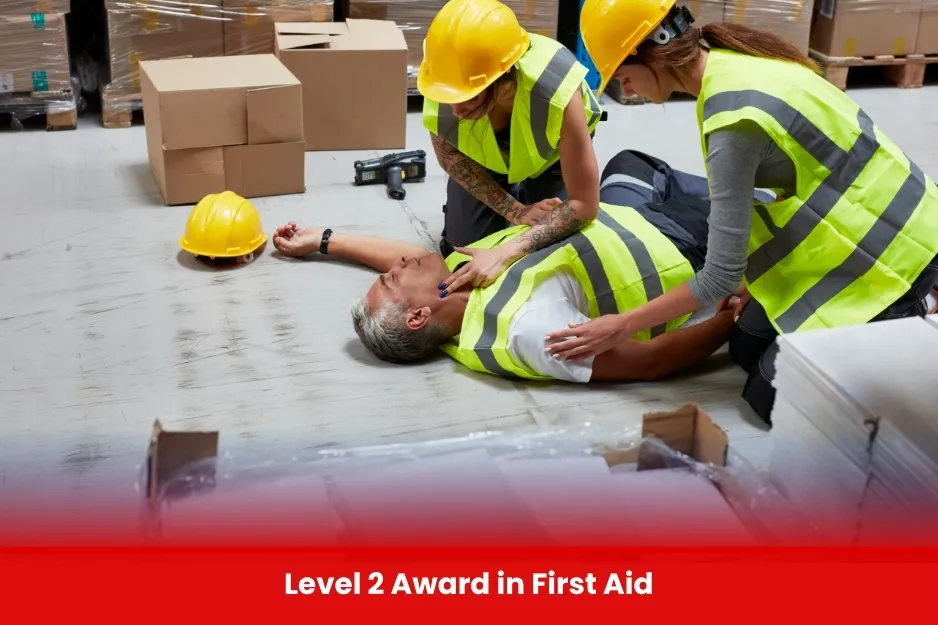Level 2 Award in First Aid
The Level 2 Award in First Aid is a practical, skills-focused qualification designed to equip learners with the knowledge and ability to respond effectively to a wide range of first aid situations in the workplace or everyday settings. It goes beyond basic awareness and prepares individuals to act as first aiders in accordance with national health and safety standards.
This course is ideal for those who may need to provide first aid in low-risk environments, such as offices, schools, shops, or community spaces. It covers essential life-saving techniques including CPR, managing an unresponsive casualty, treating minor injuries, and responding to common medical emergencies.
The qualification supports both personal development and workplace compliance, making it valuable for employees, volunteers, and anyone wishing to take on a first aid role in their organisation or community.

Aim of Level 2 Award in First Aid
The aim of this qualification is to provide learners with the essential skills, knowledge, and confidence to respond effectively to a variety of first aid emergencies. It is designed to prepare individuals to take on the role of a qualified first aider in low-risk environments.
This qualification aims to:
- Equip learners with the ability to assess and manage incidents involving illness or injury
- Teach life-saving techniques, including CPR and the use of an AED (where applicable)
- Provide the skills needed to manage unresponsive casualties, choking, bleeding, burns, and shock
Course Overview
Level 2 Award in First Aid
- Age:
Learners must be 16 years of age or older (Some providers may accept learners from age 14 with supervision, depending on local regulations.) - Physical Ability:
Learners must be physically able to carry out practical first aid tasks, such as performing CPR on the floor and placing someone in the recovery position. - Language Skills:
A basic level of English reading, writing, and communication skills is required to understand the content and complete assessments. - No Prior Qualifications Required:
There are no formal entry requirements, though prior basic knowledge of first aid (such as a Level 1
| Course Code | Curriculum Title | Credit | DLH |
|---|---|---|---|
| BUK1877-1 | Introduction to First Aid | 3 | 20 |
| BUK1877-2 | Assessing an Emergency Situation | 3 | 20 |
| BUK1877-3 | Managing an Unresponsive Casualty | 3 | 20 |
| BUK1877-4 | Dealing with Choking | 3 | 20 |
| BUK1877-5 | Managing Bleeding and Wounds | 3 | 20 |
| BUK1877-6 | Treating Minor Injuries | 3 | 20 |
Learning Objectives
- Introduction to First Aid
- Understanding the role and responsibilities of a first aider
- Legal requirements and workplace first aid regulations
- Infection prevention and personal safety (use of PPE)
- Assessing an Emergency Situation
- Conducting a primary survey (DRABC)
- Assessing the situation and ensuring safety
- When and how to call for emergency services
- Managing an Unresponsive Casualty
- Recovery position for breathing casualties
- Administering CPR (Cardiopulmonary Resuscitation)
- Introduction to and safe use of an Automated External Defibrillator (AED)
- Dealing with Choking
- Recognising mild and severe choking
- Providing appropriate back blows and abdominal thrusts (Heimlich manoeuvre)
- Managing Bleeding and Wounds
- Types of bleeding (minor, severe, catastrophic)
- Applying pressure and dressings
- Recognising and treating shock
- Treating Minor Injuries
- Small cuts, grazes, and bruises
- Minor burns and scalds
- Splinters and nosebleeds
- Responding to Common Medical Emergencies
- Seizures (epilepsy)
- Diabetic emergencies
- Asthma attacks and allergic reactions (anaphylaxis)
- Fainting and heart-related conditions
- First Aid Equipment and Incident Reporting
- Contents of a workplace first aid kit
- Safe disposal of waste and sharps
- Recording incidents and completing accident reports
- Employees in low-risk workplaces (e.g. offices, retail, education, hospitality)
- Team leaders, supervisors, or staff with designated first aid responsibilities
- Volunteers, youth workers, and community group leaders
- Parents, carers, and individuals looking to support their families
- Anyone looking to enhance their emergency preparedness or pursue a career in health and safety
- All Modules within this qualification are assessed internally by the approved training Centre and externally verified by BURRAQ UK. The program uses a criterion-referenced assessment approach to ensure that learners successfully meet all required learning outcomes.
- A Pass in any unit is granted only when the learner submits valid, reliable, and authentic evidence that demonstrates achievement of the assessment criteria. The Assessor is responsible for reviewing this evidence and confirming that the learner has attained the expected standard.
